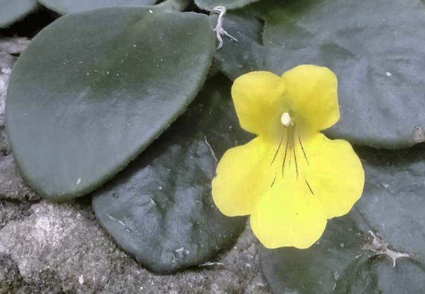Abstract
Primulina hoangmongii, a new species from Yen Bai Province of northern Vietnam, is described and illustrated. It is similar to P. albicalyx in its robust rhizome, rosette leaves, and yellow flowers. However, P. hoangmongii is clearly distinguished by its linear to narrowly-lanceolate bracts, 8–12 × 2–3 mm (vs. narrowly ovate to ovate, 18–25 × 9–14 mm), green calyx (vs. white), rich yellow corolla (vs. pale yellowish), base of the upper lip flat, thin and rich pure yellow (vs. swelling between lobes, yellow-brownish), and a ligulate, entire stigma (vs. deltoid, 2-lobed). The conservation status of P. hoangmongii is preliminarily assessed according to IUCN criteria as Critically Endangered (CR).
References
- Beentje, H. (2016) The Kew Plant Glossary, an illustrated dictionary of plant terms (2 edition). Royal Botanic Gardens, Kew, 184 pp.
- Ben Mahmoud, K., Abdelkefi, F., Mezzapesa, G.N. & Perrino, E.V. (2024) Nutritional value and functional properties of an underexploited Tunisian wild beet (Beta macrocarpa Guss.) in relation to soil characteristics. Euro-Mediterranean Journal for Environmental Integration. https://doi.org/10.1007/s41207-024-00468-5
- Clements, R., Sodhi, N.S., Schilthuizen, M. & Ng, P.K.L. (2006) Limestone karsts of Southeast Asia: imperiled arks of biodiversity. Bioscience 56: 733–742. https://doi.org/10.1641/0006-3568(2006)56[733:LKOSAI]2.0.CO;2
- Gillieson, D. (2005) Karst in southeast Asia. In: Gupta, A. (Ed.) The physical geography of southeast Asia. Oxford University Press (OUP), pp. 157–176. https://doi.org/10.1093/oso/9780199248025.003.0021
- GRC (2022) Gesneriaceae Resource Centre. Royal Botanic Garden Edinburgh. Available from: https://padme.rbge.org.uk/GRC (accessed 24 February 2024)
- Hance, H.F. (1883) New Chinese Cyrtandteae. Journal of Botany, British and foreign 21: 165–170.
- Harris, J.G. & Harris, M.W. (2006) Plant identification terminology: an illustrated glossary. Spring Lake Publishing, Spring Lake, 216 pp.
- Hickey, M.K. & King, C. (2000) The Cambridge Illustrated Glossary of Botanical Terms. Cambridge University Press, Cambridge, 208 pp.
- IUCN Standards and Petitions Committee (2024) Guidelines for Using the IUCN Red List Categories and Criteria. Version 16. Prepared by the Standards and Petitions Committee. Available from: http://www.iucnredlist.org/ (accessed 29 March 2024)
- Merrill, E.D. (1918) Notes on the flora of Loh Fau Mountain, Kwangtung province, China. The Philippine Journal of Science, section C. Botany 13: 123–161.
- Perrino, E.V., Tomaselli, V., Costa, R. & Pavone, P. (2013) Conservation status of habitats (Directive 92/43 EEC) of coastal and low hill belts in a mediterranean biodiversity hot spot (Gargano—Italy). Plant Biosystems 147 (4): 1006–1028. https://doi.org/10.1080/11263504.2013.860052
- POWO (2024) Plants of the World Online. Facilitated by the Royal Botanic Gardens, Kew. Available from: http://www.plantsoftheworldonline.org (accessed 24 February 2024)
- Simpson, M.G. (2019) Plant systematics. 3 ed. Elsevier, Amsterdam etc., 761 pp. https://doi.org/10.1016/B978-0-12-812628-8.50001-8
- Thiers, B. (2024) Index Herbariorum: A global directory of public herbaria and associated staff. New York Botanical Garden’s Virtual Herbarium. Available from: http://sweetgum.nybg.org/science/ih/ (accessed 24 February 2024).
- Wagensommer, R.P. & Venanzoni, R. (2021) Geranium lucarinii sp. nov. and re-evaluation of G. kikianum (Geraniaceae). Phytotaxa 489 (3): 252–262. https://doi.org/10.11646/phytotaxa.489.3.2
- Weber, A., Middleton, D.J., Forrest, A., Kiew, R., Lim, C.L., Rafidah, A.R., Sontag, S., Triboun, P., Wei, Y.G., Yao, T.L. & Moller, M. (2011) Molecular systematics and remodelling of Chirita and associated genera (Gesneriaceae). Taxon 60 (3): 767–790. https://doi.org/10.1002/tax.603012
- Wei, Y.G., Do, V.T. & Wen, F. (2022) A Checklist to the Plants of Northern Vietnam. China Forestry Publishing House, Beijing, 606 pp.
- Xu, Z.R. (1995) A study of the vegetation and floristic affinity of the limestone forests in southern and southwestern China. Annals of the Missouri Botanical Garden 82: 570–580. https://doi.org/10.2307/2399837
- Yang, L.H. & Pan, B. (2017) Primulina albicalyx (Gesneriaceae), a new species from a karst area in Guangxi, China. Willdenowia 47 (3): 311–317. https://doi.org/10.3372/wi.47.47312
- Zavatin, D.A., Ramos, R., Watanabe, M.T.C., Pedrosa, L.G. & Lírio, E.J. (2023) A new species of Mollinedia (Monimiaceae, Laurales) from the Quadrilátero Ferrífero, Brazil. PhytoKeys 234: 189–201. https://doi.org/10.3897/phytokeys.234.109804


